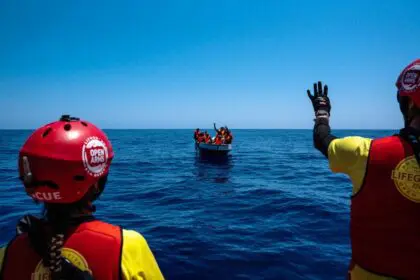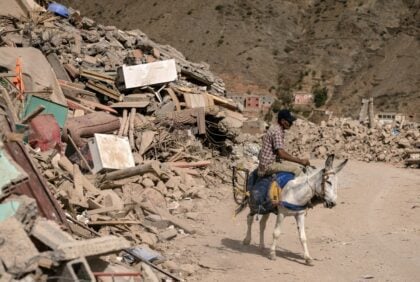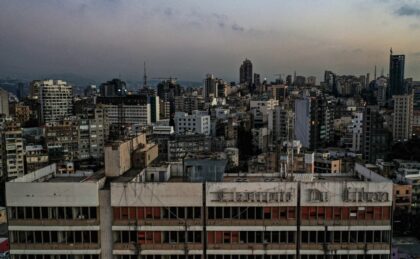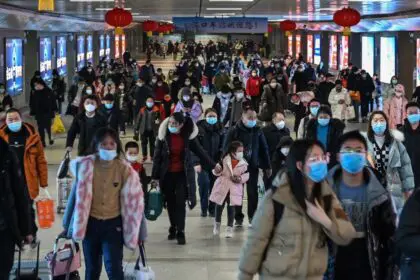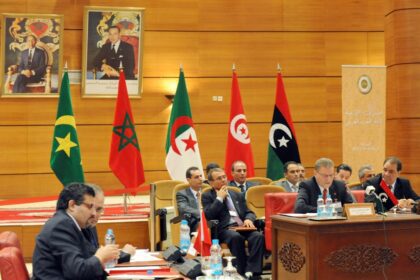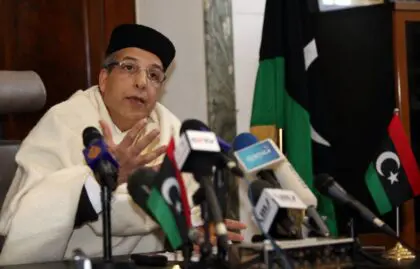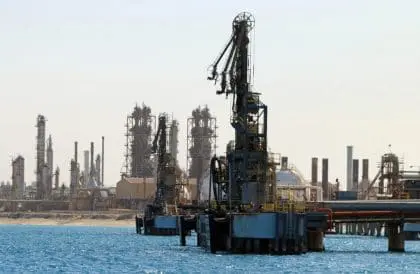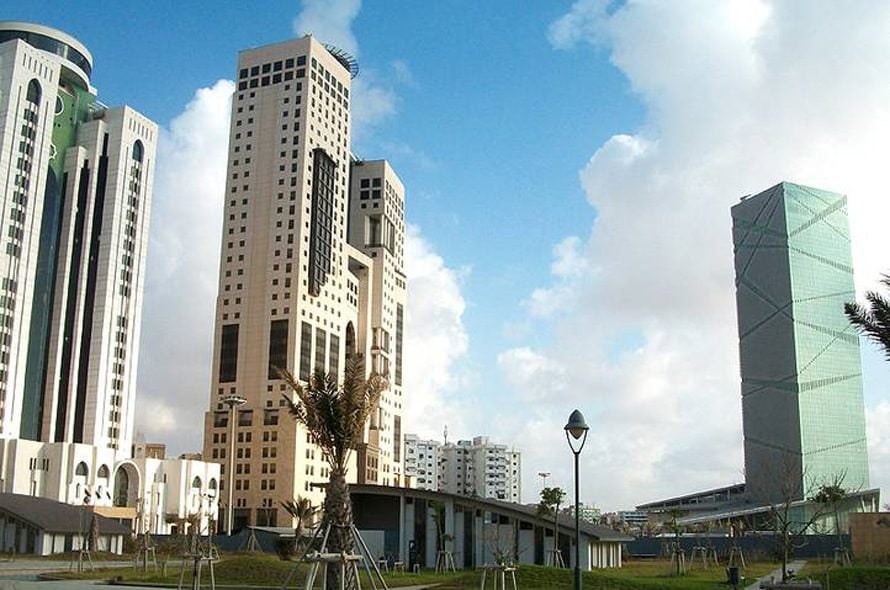
Introduction
Libya’s economy, almost entirely dependent on oil and gas exports, has struggled since 2014 given security and political instability, disruptions in oil production, and decline in global oil prices. The Libyan dinar has lost much of its value since 2014 and the resulting gap between official and black market exchange rates has spurred the growth of a shadow economy and contributed to inflation. The country suffers from widespread power outages, caused by shortages of fuel for power generation. Living conditions, including access to clean drinking water, medical services, and safe housing have all declined since 2011, According to the World Factbook of the CIA. Oil production in 2017 reached a five-year high, driving GDP growth, with daily average production rising to 879,000 barrels per day.
As the oil sector is the major source of growth, economic activities remain constrained by recurrent clashes around oil infrastructure aiming to control oil wealth.
The World Bank sees the country’s ambition to raise oil production to 1.6 million (bpd) -Highest level before the revolution- proved overly optimistic, as this objective is systematically disrupted by political rivalries. The associated lack of security and reforms hinders investment and development of the private sector.
The status quo scenario determined by resource competition in a context of delayed resolution of the political strife and the persistence of internal division and inoperative institutions makes stabilization unlikely, According to the World Bank Group. This fragile situation is weakened further by recurring clashes around oil terminals and in large cities, mostly aiming to gain control over oil wealth. In this context, Libya can only manage to keep oil production to a daily average of 1 million bpd during 2019 and 1.1 million bpd over the next few years
The Central Bank of Libya continued to pay government salaries to a majority of the Libyan workforce and to fund subsidies for fuel and food, resulting in an estimated budget deficit of about 17% of GDP in 2017. Low consumer confidence in the banking sector and the economy as a whole has driven a severe liquidity shortage.
Gross Domestic Product
The Libyan economy is heavily dependent on hydrocarbons, making it sensitive toy changes in the security situation. The improvement in political and security conditions during the second half of 2017 allowed Libya to double its oil production and achieve record growth (26.7 per cent increase) after four years of stagnation. This did not last through the first half of 2018, however, according to the World Bank.
The status quo, marked by the delay in resolving the political conflict and ongoing internal divisions, renders sustainable stability improbable. One feature of this situation is the repeated clashes around oil facilities and in major cities, meaning that any recovery will lead to increased competition for the resources. In this context, Libya can only produce oil at an average of 1 million barrels per day by the end of this year and maintain production around this level in the next few years, which is a third of production capacity. The World Bank predicts that the gross domestic product (GDP) will grow 6.8 per cent in 2019 (catch-up effect) and 2 per cent on average in 2020-2021, which means a 62.5 per cent per capita GDP increase from the 2010 level.
| Indicators | measuring unit | 2016 | 2017 | Change ± |
| GDP (at constant 2010) | Billion US$ | 36.809 | 46.628 | 9.819 |
| GDP growth (annual) | % | -2.8 | 26.7 | 29.5 |
| GDP per capita (constant 2010) | US$ | 5.549 | 7.315 | 1.766 |
| GDP (at current value) | Billion US$ | 26.222 | 38.108 | 11.886 |
Source: World Bank.
Poverty
Analysts attribute the causes of poverty in Libya after the February 2011 revolution to the economic downturn, high rates of inflation and unemployment, lower public spending and the spread of corruption. Economic output has shrunk sharply since the closure of strategic oil export ports in the eastern oil crescent (Zuwetina, Brega, Ras Lanuf, Sidr and Haruj) and the closure of the el-Feel and el-Sharara fields in western Libya.
According to observers, the most important manifestations of corruption in Libya are the squandering, depletion and syphoning off of public funds, such as duplicating or falsifying public sector salaries or through overstaffing in public institutions. Libya was ranked 161st out of 168 countries in the Corruption Perceptions Index 2015 and ranked last in the Arab world.
High inflation, poor service delivery and increased social and economic exclusion have contributed to the increase in poverty rates. Inflation, in particular, which reached a record high of 28.4 per cent in 2017, has pushed up commodity prices, driven primarily by the severe shortage of major commodity supply chains, increasing black market speculation and the sharp devaluation of the Libyan dinar in parallel markets.
Agriculture and Fisheries
Gaddafi hoped a developed agricultural sector would counterbalance the dependence on oil. In his early long-range plans, 22 percent of the resources were earmarked for agriculture, but only 5 percent of Libyan soil is suitable for seasonal agriculture and less than 2 percent receives enough precipitation for permanent agriculture.
The Bank for Agricultural Development assigned large interest-free loans to purchase agricultural machinery, fertilizers, and seeds, and large-scale farming projects were initiated, such as the Great Man-Made River project and the Kufra irrigation project. The results were disappointing because of the lack of arable land and an experienced labour force. This led to over-exploitation of land and misuse of fertilizers.
The development of rural areas was seriously affected by international diplomatic problems. The expulsion of Egyptian workers following the Camp David Agreements in 1978 deprived Libya of its agricultural labour force. The one-house-per-family policy of the government meant that family houses outside towns were occupied by Bedouins and the fields were not maintained.
In short, agriculture has long been stagnant. In 1961 agricultural land represented 6.3 of the land surface, and in 2011 it was estimated at 8.9 percent. Over the same period, arable land increased in area from 1,700,000 to 1,750,000 hectares.
Libya nowadays depends on imports for 75 percent of its food. About 17 percent of the population works in agriculture, although figures are not precise because a great deal of agricultural work is unrecorded: crops are grown for self-consumption and in cooperative family enterprises. In Jebel Nafusa, for instance, all members of the family participate in the annual olive harvest and in maintaining the groves.
Agriculture contributes 3.6 percent of GDP, industry (mainly the hydrocarbon sector) 56.7 percent, and services 39.7 percent (CIA World Fact Book). 17 percent of the labour force works in agriculture, 23 percent in industry, and 59 percent in services. The main products of the agricultural sector are wheat, barley, olives, dates, citrus fruits, vegetables, peanuts, soybeans, and cattle.
Fisheries
Although Libya has a Mediterranean coastline of almost 2,000 kilometres with an ancient history of human settlement, there is no strong tradition of fishing and fish consumption in contemporary society. Until recently, much of the artisanal and small trawler fishery was carried on by Italians and Maltese based in Tripoli and a few other major ports, whilst Greeks were especially active in the sponge fishery. Local participation and production levels have undoubtedly increased since the 1970s, and this trend has been strongly encouraged by fisheries authorities, through extensive investments in port and onshore infrastructure and services.
In the mid-1980s it was reckoned that the inshore artisanal fleet of wooden small craft (less than 10 metres in length) amounted to no more than 400 vessels and that perhaps as many as 20 stern- or side-trawlers were operational. Annual production in the 1970s and 1980s reportedly ranged from a few thousand to as much as 10,000 tonnes, though a weak data-collection system opens to question the reliability of available statistics. It is believed, in any case, that most production from Libyan waters in previous years was accounted for by unlicensed foreign vessels. The apparent growth in the artisanal fleet has been remarkable, with total units presently numbering almost 3,500. The industrial fleet has also undergone significant expansion, with some 90 units – trawlers and a few purse seiners and long-liners – now based in domestic ports. Production, too, has shown a significant rise in recent years, according to official figures. In 1994 the total catch was reported to stand at about 33,000 tonnes.
It can be estimated, on the basis of the 1993 coastal fisheries survey, that artisanal production provides direct full-time or part-time employment for about 4,500 small-craft owners and crew and about 5,000 mostly part-time fishers working along shore with hook-and-line, gillnet, castnet, and hand collection. A current workforce of roughly 150 is estimated for the industrial fishing sector. Secondary sector employment in servicing and support activities at major landing sites is reckoned to involve about 250–300 part-time and full-time people. The post-harvest industry is estimated to provide direct employment, both permanent and seasonal, for some 2,000 processing-plant workers, fish merchants, and technical personnel.
With a primary and secondary productive employment base of about 12,000 people, the fisheries sector thus accounts for only a small fraction, about 1 percent, of Libya’s total labour force. To put this into perspective, in a national economy heavily dominated by the hydrocarbon sector, the entire agriculture sector itself contributes only an estimated 6 percent of total GDP.
Industry
Gaddafi’s attempt to create an independent industrial base was as unsuccessful as his pursuit of a self-sufficient agricultural sector, so the focus shifted to an independent industry. The sector consisted mainly of industries closely connected with the oil industry, such as steel, iron, and aluminium. The Libyan Iron and Steel Company, which was started in 1979, was heavily subsidized and became one of the largest companies in Libya and one of the largest iron and steelmakers in North Africa. Its iron ore is largely imported, although there are large reserves of iron ore in southern Libya. Gaddafi was unable to exploit these because no foreign investors were interested. Smelting power comes from local natural gas. On this basis it was, by the mid 2000s, making a substantial profit, but Libya’s limited market and Europe’s protective regulations created overcapacity.
Agriculture contributes 3.6 percent of GDP, industry (mainly the hydrocarbon sector) 56.7 percent, and services 39.7 percent (CIA World Factbook). 17 percent of the labour force works in agriculture, 23 percent in industry, and 59 percent in services.
The main products of the industrial sector are petroleum, petrochemicals, aluminium, iron and steel, processed foods, textiles, handicrafts, and cement.
No private entrepreneurship
In the late 1970s, the regime accelerated implementation of the socialist policies outlined in the second part of the Green Book. Gaddafi described a sort of popular capitalism in which the people were shareholders and rejected private entrepreneurship, as the masses would not benefit from revenues.
The core economic ideology was reflected in three slogans: ‘The occupier of the house is the owner’, ‘No wage workers but partners’, and ‘Trade is exploitation’. In 1978, property was redistributed. Owners had to choose one house for themselves, and the rest of their real estate was allocated or appropriated. It was forbidden to demand rent. This brought the construction sector to a standstill, but almost every Libyan was provided with housing. The same year marked the beginning of a campaign to place the means of production under systems of worker self-management. In May 1980 the currency system was virtually entirely demonetized, with a deliberately redistributive purpose. In early 1981 the state took over all import-export and distributive functions. Almost all private shops were replaced by huge state-run supermarkets. Only carpet weavers and shoemakers were exempted; disgruntled ex-retailers joined the ranks of Gaddafi’s opponents. Per capita GDP fell from USD 10,261 in 1981 to USD 5,646 in 1987.
Sanctions and bad management
A further blow came with the sanctions imposed by the United Nations and US in 1992, which inflicted severe damage on Libya’s economy. International air traffic was banned, as was the sale of weapons and parts for aircraft. All Libyan assets were frozen, except those required for oil transactions. The US sanctions enacted in 1986 forced US oil companies to cease operations.
Economic growth between 1992 and 1999 was 0.8 percent per year. 1993 and 1994 witnessed a negative growth of 7 percent per year, leading to massive layoffs among workers and price rises. Per capita GDP, which had climbed back up in the late 1980s, immediately fell again, from USD 7,982 in 1992 to 5,864 in 1995 and 5,951 in 1998. The Libyan government estimated it missed out on more than USD 30 billion in revenues and production capacity. Quite apart from the damage caused by the sanctions, the crisis was magnified by the structural problems, poor functioning, and bad management by the regime. Dilapidated factories and other buildings and poorly maintained roads were common.
The response was to allow a limited return of private enterprise, beginning in 1992. As in former communist countries, a group of traders became rich from scratch in a few years. In 1996, the government set up purification committees to combat excesses. Supermarkets filled with imported goods were closed and shop owners imprisoned, but the importation of food slowly returned to private hands, and this process accelerated in the 2000s.
The wholesale move to a free-market economy was planned to be finished on the fiftieth anniversary of Gaddafi’s revolution, in 2019. Libya aimed to become a centre of trade between Europe, Africa, and the Caspian Sea countries. Libya proclaimed itself the Gateway to Africa, and a free port in Misrata supported that goal.
But Libya had a long road ahead in liberalizing its socialist-oriented economy. Before the 2011 revolt, the importation of food moved increasingly to private importers. Legislation for a private sector was slowly enforced. Libyans were promised they could reclaim ‘lost’ property. A construction boom took place.
Infrastructure
Providing infrastructure in Libya has always faced the enormous problem of providing for a small population over vast distances. The Gaddafi period added a second problem – how to provide an infrastructure that would underpin ideologically-driven development. His various attempts to decentralize the government by moving departments to other regions are an example of this, along with abortive attempts to create alternate centres of administration.
In 1987, apparently as an attempt to restructure completely a recalcitrant bureaucracy, Gaddafi declared that a new capital would be set up in Jufra. The project soon vanished, but the following year attention turned to Sirte, once the nearest village to Gaddafi’s place of birth. This became the focus of a huge public-works programme to turn it into a city, as government departments and the Libyan Parliament were relocated there, although Tripoli remained the legal capital of the country. After the end of sanctions, more money was put into infrastructure generally, but, even then, government expenditure was modest – in 2006 about USD 5.3 billion was allocated to infrastructure expenditure, including housing, water, and roads. Of this transportation, telecommunications, and storage accounted for USD 225 billion.
Roads
Libya’s historic caravan routes are now asphalted. The trunk of the road system is the main route from Tunisia along the coast to Egypt, linking Tripoli and Benghazi, and a north-south route to Sabha and Murzuq.
The extreme distances in a harsh climate demand constant upkeep, which was not provided during the sanctions period, when the long-distance road network deteriorated. In 2000 there were 83,300 kilometres of roads, of which 57 percent was paved. When sanctions were lifted, the Gaddafi regime concentrated on increasing the quantity and quality of the infrastructure. By 2012 paved roads totalled than 57,000 kilometres of a total network of, 100,000 kilometres. In 2007 there were 290 motor vehicles registered for every 1,000 people, of which 225 were cars.
Railways
Libya is the only country in the Maghreb without a railway network. Lines built for military purposes during the Italian colonization have long been disused.
As early as 1977, the Libyan National Atlas showed plans for a rail network along the Mediterranean coast, linking Tunisia and Egypt, with a line south to Sabha, but it was never constructed. In the final years of the Gaddafi regime, a project to build a 3,170-kilometre national rail network was begun.
The scheme, costed at USD 12 billion, was divided between Russian Railways, which was to build a line between Sirte and Benghazi, and the China Railway Construction Corporation, which was given a contract in 2008 to build 352 kilometres of coastal railway from Khomsto Sirte and later another 172 kilometres from Tripoli to Ras Ajdir, on the Tunisian border, and an 800-kilometre line between Misrata and Wadi al-Shati, near Sabha, an area rich in iron ore.
Before the revolution, some work had started, and rolling stock was delivered for the Benghazi-Sirte line. This stopped during the civil war, but in February 2013 the General National Congress announced that the project would be restarted, under new management.
Air transport
Libya has 144 airports, 64 with paved runways and 80 with unpaved runways. Main airports are in Tripoli, Benghazi, Tobruk, Sirte, Brega, Sabha, Ghat, Ghadames, and Kufra. There are other military airports.
Before the 2011 revolution, the national airline was Libyan Arab Airlines (LAA), founded as Kingdom of Libya Airlines in 1965. In the 1970s LAA built up a fleet of planes sourced in the US (mainly Boeings) to service an extensive network linking Libya with Europe, the Middle East, and South Asia. The imposition of sanctions in 1992 included both the delivery of new aircraft and landing and overflight rights in other countries. All international flights ended, and LAA, confined to domestic routes, was unable to buy spare parts for its fleet. It purchased some Soviet-built aircraft to replace them until sanctions were lifted.
When sanctions were lifted, Libyan Arab Airlines began to rebuild its international network and ordered new aircraft from Airbus and other companies. In 2001 two new airlines began operations. The first was a second state-owned company, Afriqiyah Airways, which was set up in partnership with an Italian airline, Blue Panorama. It relies almost exclusively on Airbus aircraft which it uses on routes in Africa and the Middle East and a few European destinations. The other was the first privately owned airline, Buraq Air Transport, in which Gaddafi’s wife Safia had a large holding. It served domestic airports and a few in the Middle East. After the war, it opened routes to Tunisia and Morocco.
In 2010, 2,430,996 passengers transited through Libyan airports. In 2011 this number fell to 1,895,908. Freight in 2010 was 300,000 tonnes.
Banking
The Central Bank of Libya was established in 1956. For most of the Gaddafi period, it oversaw an almost exclusively state-owned banking system. Private-sector banking was re‐established in 1993 but did very little. More active privatization efforts began in 2007. BNP Paribas acquired a 19-percent stake in Sahara Bank, with plans to purchase up to 51 percent by 2012. In early 2008, Arab Bank acquired Wahda Bank, with a similar timeline towards a controlling ownership. When the rising against Gaddafi began, BNP pulled out all its staff, and they had still not returned by May 2013.
Almost immediately after the establishment of the TNC in Benghazi in 2011, it set up its own Central Bank (CBL) to administer financial affairs until Tripoli itself was occupied. In March 2011 the UN Security Council froze Libya’s foreign holdings. Gaddafi’s governor of the CBL, Farhat Omar Bengdara, resigned in March 2011, and the TNC appointed Sadeq al-Kabir to succeed him. In December Libyan foreign holdings were unfrozen. In January 2012 the CBL started withdrawing the old currency in order to restore liquidity in the country’s banking system, because the vast majority of funds were held outside banks. On 6 January 2013, the General National Congress passed a law that introduced Islamic banking and banned interest on financial transactions, giving banks two years to become fully Sharia compliant.
In July 2013 al-Kabir was sacked, for unexplained reasons but perhaps because he had worked under the Gaddafi regime.
Libya’s stock exchange was established in 2006. In 2007 it signed a training agreement with the London Stock Exchange. It closed in February 2011 and reopened in March 2012, listing the shares of 12 companies, mostly banks and the exchange itself, with a total market capitalization of USD 3 billion. In July 2013 the exchange signed an agreement [with whom?] to expand the role of Islamic finance in the Libyan economy.
Tourism
For years, Libya was difficult of access, but in the late 2000s the Gaddafi regime began planning to attract foreign investors in tourism. The General Tourism Authority’s budget for improvement of facilities in 2007 was USD 70 million.
In 2008 there were 34,000 tourist arrivals in Libya (World Bank) between 250,000 and 320,000 tourists visited Libya, contributing 0.2 percent of export earning two-thirds of its visitors were European. In 2005, there were 125,000 hotel beds available, which is to be expanded. The Maltese-Libyan Corinthia Bab Africa Hotel in Tripoli is the country’s only five-star hotel.
Libya has much to offer tourists. The country is home to five World Heritage Sites (see Nature reserves; Greeks and Romans).
Basic Indicators
| Indicators | 2016 | 2017 |
| Total public revenues (billion US$) | - | 15.78 |
| Total public expenditure (billion US$) | - | 23.46 |
| Budget deficit (billion US$) | - | -7.68 |
| Total exports | 11.990 | 18.380 |
| Total imports | 8.667 | 11.360 |
| Trade Balance Surplus | 3.323 | 7.020 |
| Public debt to GDP (%) | 7.5 | 4.7 |
| Fiscal year | تقويم ميلادي | تقويم ميلادي |
| Inflation (%) | 25.9 | 28.5 |
| Reserves of foreign exchange and gold (billion US$) | 66.05 | 74.71 |
| Exchange rates (US$ per DL) | 0.719 | 0.708 |
Source: CIA World Factbook.
Latest Articles
Below are the latest articles by acclaimed journalists and academics concerning the topic ‘Economy’ and ‘Libya’. These articles are posted in this country file or elsewhere on our website:


